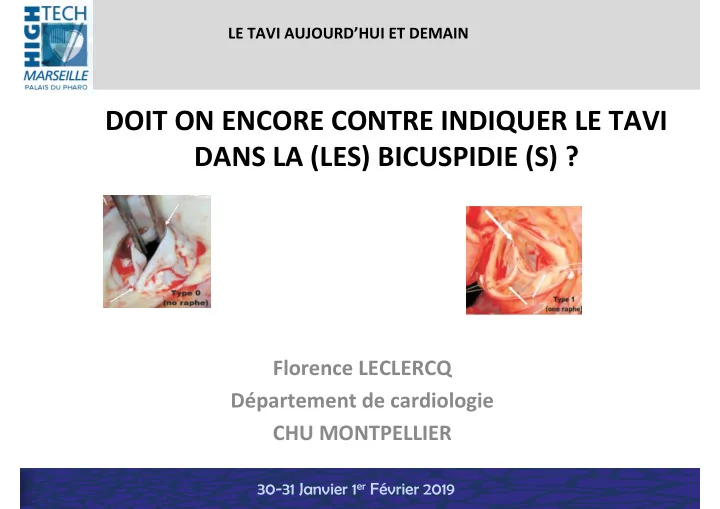

LE TAVI AUJOURD’HUI ET DEMAIN DOIT ON ENCORE CONTRE INDIQUER LE TAVI DANS LA (LES) BICUSPIDIE (S) ? Florence LECLERCQ Département de cardiologie CHU MONTPELLIER 30-31 Janvier 1 er Février 2019
CONFLITS D’INTERETS • Subventions et honoraires – Edwards Lifesciences – Medtronic 30-31 Janvier 1 er Février 2019
BICUSPID AORTIC VALVE WHAT ARE THE CURRENT ISSUES ? • The most common congenital valvular abnormality (0.5 % to 2% of the general population), the majority of aortic valve replacements in patients below the age of 60 • Historically considered as a contraindication to TAVI • Populations of TAVI are more likely to include patients with bicuspid valves (worldwide shift of treating younger and lower surgical-risk patients) • New generation valves and growing experience may provide better results in challenging anatomies such as bicuspid AS 30-31 Janvier 1 er Février 2019
30-31 Janvier 1 er Février 2019
30-31 Janvier 1 er Février 2019
Post-implantation aortic regurgitation (AR) ≥ grade 2 occurred in 28.4% but which appears to be mitigated (17.4%) by MSCT- based TAV sizing (performed in 2/3 patients ) 30-31 Janvier 1 er Février 2019
30-31 Janvier 1 er Février 2019
ANATOMY IS CHALLENGING • Complex anatomy : more aortic root calcification , asymetral calcification of leaflet or raphe, smaller LVOT, dilated aorta Malposition, PVL, annulus rupture, acute aortic regurgitation, conductive disorders (strokes?) • Ellipically shaped annulus valve underexpansion or hemodynamics (gradient or PVL), durability • Sinuses are more often effaced Coronary obstruction/injury of the sinuses 30-31 Janvier 1 er Février 2019
DIAGNOSTIC IS CHALLENGING • Underestimation of bicuspid valve with ETT either ETO • MSCT—which has become the gold standard —is used to diagnose bicuspid valve and its type (Sievers 0, 1 or 2 or Jilaihawi), analyse the aortic root anatomy, and characterise the calcium load and distribution . • However identifying bicuspid valves remains difficult particularly in patients with extremely calcified anatomies. 30-31 Janvier 1 er Février 2019
SIZING IS CHALLENGING Lack of consensus concerning the optimal sizing • methodology: to avoid aggressive oversizing Supra-annular sizing (inter Commissural Distance 4–8 • mm above the annular plane), in combination with the dimension of the aortic annulus (the perimeter- derived diameter at annulus level) CT area showed the highest correlation and the best • agreement with intraoperative sizing? Sizing in grey zones: ballon sizing ? • The optimal ratio annulus/device remain to • determine (registries ongoing) 30-31 Janvier 1 er Février 2019
CHOICE OF THE VALVE IS CHALLENGING No direct comparative studies • The balloon-expandable valve • Greater radial force : to circulate the native annulus and obliterating – potential sites of paravalvular AR. – External skirt of the Sapien 3: decrease risk of paravalvular AR – calcified nodules or raphe: may impair complete prosthesis expansion – Potential risk of rupture ? The self-expanding prostheses • Supra-annular position: potentially improve hemodynamic outcomes with – non circular annulus – External wrap of the EVOLUT Pro: decrease risk of paravalvular AR – Reduced radial strength relative to balloon-expandable valve and frequent need to post dilatation Last generation valves: lotus and accurate ? • 30-31 Janvier 1 er Février 2019
30-31 Janvier 1 er Février 2019
2018 30-31 Janvier 1 er Février 2019
TIPS AND TRICK ? Evaluation of the anatomy on MSCT imaging ++ (raphe, commissures, • calcification, aortic anatomy, LVOT) Predilatation (undersize ballon) • No oversizing but correct sizing, contrast injection in grey zones • High implantation (supra annular functioning, valve anchoring, • conductive disorder) Pacing with self expandable THV • Post dilatation (valve expansion, gradient, PVL) • ETO if required • 30-31 Janvier 1 er Février 2019
TAKE HOME MESSAGES TAVI in bicuspid valves is possible with new generation THV and associated • with high rates of device success and low rates of early safety events A perfect understanding of the anatomy of the valve and the aortic root is • required. MSCT is the basis of the diagnosis and anatomic evaluation. Specific sizing rules • need to be defined. The choice of device type depends on the preferences of the individual heart • team. Second-generation devices seem to share equivalent outcomes, place of new devices have to be evaluated TAVI is not contra indicated in bicuspid valve but surgical indications • probably remain : high degree of valve calcification (raphe) , unfavorable aortic anatomy Large prospective registries and long follow-ups are required to explore the • outcomes (pace makers and durability ) 30-31 Janvier 1 er Février 2019
Recommend
More recommend